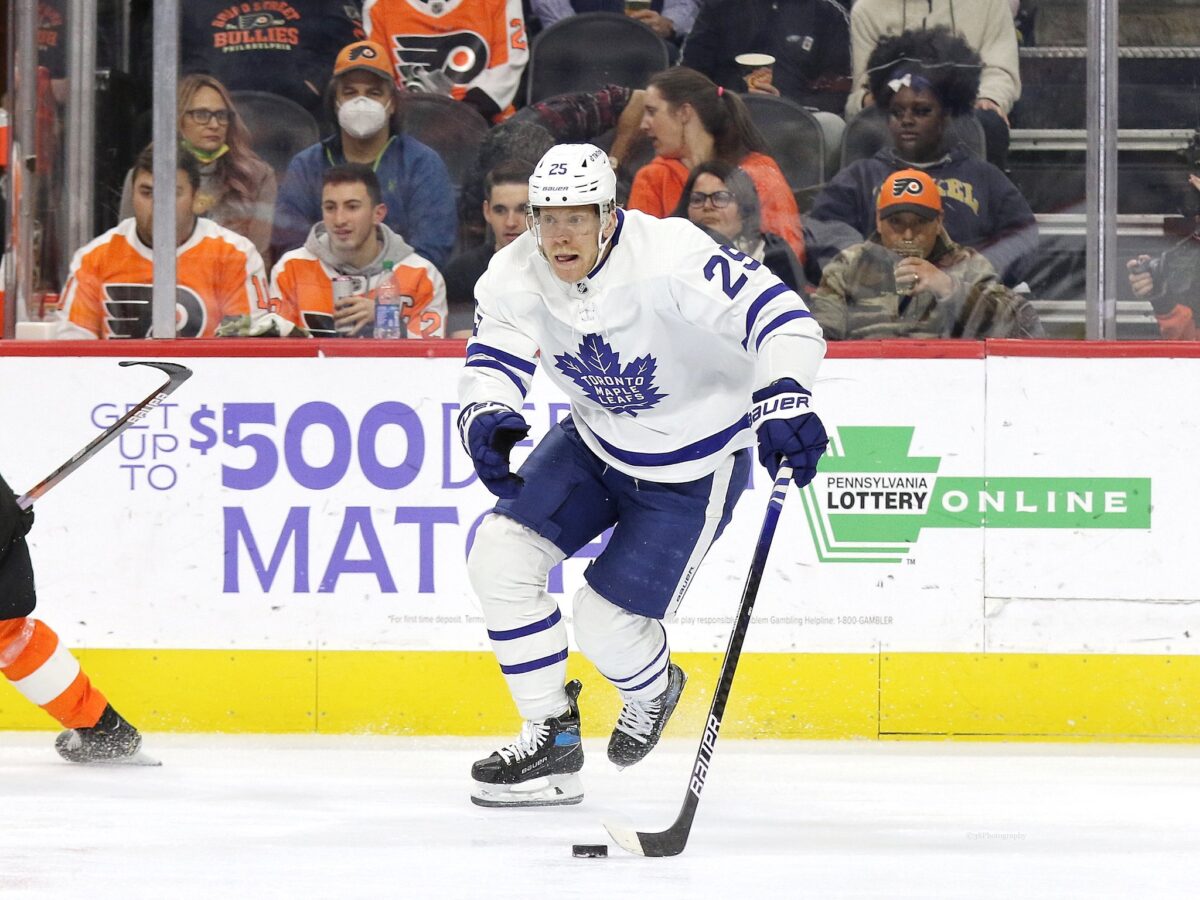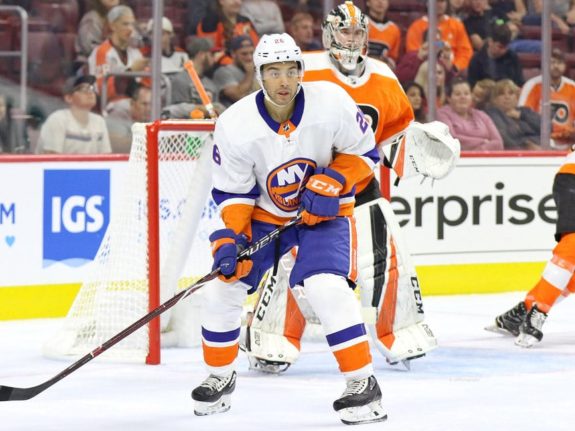The Toronto Maple Leafs have found themselves among the teams making big moves in previous offseasons. They made the “big splash” prior to 2018-19 by signing John Tavares, they traded Nazem Kadri to the Colorado Avalanche in July 2019, and they signed defenseman T.J. Brodie prior to the 2020-21 season. This past offseason, general manager Kyle Dubas mostly kept things on the down low, but still made good on most of his signings. The ironic part here is that of Dubas’ five major offseason signings, the two most expensive ones were the ones that failed the most.
Related: Maple Leafs Re-Signing Giordano Sends Messages to Team & League
Petr Mrazek, who signed a three-year contract with an average annual value (AAV) of $3.8 million this past summer, had his season derailed by injuries, and had his worst career season to date when he was healthy, finishing with a goals-against average (GAA) of 3.34 and a save percentage (SV%) of .888. Meanwhile, Nick Ritchie, who signed a two-year contract with an AAV of $2.25 million, only managed two goals during his time with the Maple Leafs, and was traded to the Arizona Coyotes in a deal that brought defenseman Ilya Lyubushkin to Toronto.
The other three signings in Michael Bunting, David Kampf, and Ondrej Kase, however, could not have worked out better. Bunting finished as a Calder Trophy finalist with 23 goals and 63 points in 79 games, while Kampf tallied career highs in points and goals, and played a crucial defensive role all season. Kase found himself on the injured reserve for a chunk of the season, but still managed 27 points in 50 games.

Bunting and Kampf are both entering the final year of two-year contracts: Bunting makes $950,000, while Kampf makes $1.5 million per year. Kase, on the other hand, made $1.25 million last season, and is a restricted free agent (RFA). The Maple Leafs own his rights, unless another team tries to offer sheet him, and at that point then the Leafs could either match the offer or earn a draft pick as compensation. While he was a great bottom-six forward during his time in the blue and white, there’s a decision to be made on whether or not bringing him back would be worth it.
The Pros of Bringing Back Kase
Although nobody should seriously blame players for getting injured, fans seem to have a natural tendency to grow tired of players who find themselves frequently on the injured reserve. Joffrey Lupul was a perfect example of this back in the mid-2010s as somebody who made an impact whenever he was in the lineup, but only had a portion of games to show for said impact. So, in signing somebody like Kase, who found himself missing time with injuries 12 times in his career prior to this season, there was obviously going to be risk involved.
You may also like:
- Bill Barilko, the Tragically Hip & the Most Famous Goal in Maple Leafs History
- NHL Rumors: Maple Leafs, Flames, Utah Hockey Team Nickname
- Maple Leafs News & Rumors: Samsonov, Reaves, Kampf & Woll
- Maple Leafs Fall to Bruins in Penalty-Filled Game 1
- Projected Lineups for the Maple Leafs vs Bruins – Game 1
However, fans instantly warmed up to Kase, and with his style of play, it suddenly became easy to see why he was constantly injured — at least it was for me. As teammate Jason Spezza described him, he plays like a buzzsaw. He’s always the first one into the corners when his line is on the ice, and he never ever takes a shift off. You notice his presence whenever he’s on the ice, and on top of that, he’s a great outlet for secondary scoring. It was on display with his 14 goals, his most since 2017-18 when he scored 20.
We also learned during the season that Kase is lifelong buddies with Kampf, his teammate and occasional linemate. The two played together in their youth playing days, they’ve both represented Czechia internationally, and their chemistry found itself on display a number of times this season. Kampf’s presence in Toronto may be enough to sway Kase to come back for one more season, but before the Maple Leafs do that, there are definitely some other factors to consider.
Kase’s Durability May Not Be Worth Re-Signing Him For
I am aware that I just talked about how Kase’s hustle and how it gives him a pass for finding himself on the injured reserve as much as he is, but that doesn’t mean it’s not something that could work against the Maple Leafs if they bring him back. As previously stated, Kase made $1.25 million on his contract last season, and while it likely won’t warrant much of a raise, he was productive enough when healthy that I would imagine he’ll likely command at least $2 million.
Can the Maple Leafs afford this? Sure they can. But would it be worth investing that kind of money for a player who you may only be able to count on playing half of the games? That’s the question that makes this whole situation tricky. Not only that, but as I said earlier, Kase being an RFA means that the Maple Leafs would get a draft pick if another team were to offer him a contract, and Toronto chooses not to match the offer.

I’m not Kase’s agent, and I’m not going to pretend I know how much money he’s going to ask for. But if I had to guess, I’d imagine it would be somewhere between his salary from last season, and roughly $4 million per season. If he were to sign a contract elsewhere with an AAV between $1.3 – $2.1 million, the Maple Leafs would get a third-round pick as compensation. If he were to sign between $2.1 million and $4.2 million, the Maple Leafs would get a second round pick.
The Leafs don’t have a second-round pick or a third-round pick in 2023, so it might be wise for them to allow Kase to entertain offers from other teams and take whatever compensation they get for him. He was good this season, but he wasn’t necessarily a game changer in the playoffs, and if the Maple Leafs were to let him go, his role is one that could be filled either through free agency or internally.
Maple Leafs Have Young Forwards Ready to Take the Next Step
If the Maple Leafs choose to release Kase, there are a number of contenders on the Marlies and from other sources who could compete for his spot in the lineup. One of the obvious names here is Nick Robertson. The Maple Leafs’ second-round pick in 2019 has quickly outgrown the American Hockey League (AHL), having tallied 16 goals and 28 points in 28 games for the Toronto Marlies this season. He hasn’t really played well enough at the NHL level to secure himself a full-time roster spot with the Maple Leafs, but then again he hasn’t had a sample size longer than ten games.
Another option is Alex Steeves. The former University of Notre Dame star was signed to an entry-level contract last spring, and impressed in his first AHL season by notching 46 points in 58 games. He’s one of the fastest players the Marlies have, and a strong training camp could give him an extended look in preseason. Also on the radar is Josh Ho-Sang, the former New York Islanders first-round pick who just played out a full season with the Marlies on an AHL contract. He had a nice rebound, putting up 35 points in 47 games.

There’s also Pontus Holmberg, the Maple Leafs’ sixth-round pick in 2018, who just wrapped up a career year with the Swedish Hockey League (SHL)’s Vaxjo Lakers, finishing with 41 points in 46 games. Holmberg signed an entry-level contract with the team in June 2021, and he has the makings to be an effective bottom-six forward at the NHL level. Even outside of all these players I just mentioned, there are always bargain bin players available for cheap that Dubas could look to replace him with. The bottom line is the Maple Leafs won’t be in dire need of a forward if Kase chooses to leave.
Maple Leafs Should Lean Towards Getting Compensation for Kase
I say this very loosely, but I don’t necessarily want the Maple Leafs to get rid of Kase. Like I said, he was a pleasure this season, and me saying the Maple Leafs shouldn’t rush to sign him has nothing to do with his play. Ideally, every head coach wants a couple of players like Kase, and if he’s willing to come back to the team for a similar price, at least for one more season, I would definitely be here for it.
You May Also Like
- Maple Leafs Can Address Missing Killer Instinct in Free Agency
- Trade Candidates in Rumored Maple Leafs’ Big “Summer of Kawhi” Deal
- Maple Leafs’ D-men Liljegren & Sandin Are Ripe for Offer Sheets
- Maple Leafs’ 2022 Offseason Trade Targets: Chicago Blackhawks
But on the other hand, if Kase is looking for a raise, the Maple Leafs shouldn’t bend over backwards to change his mind. They have a relatively depleted draft capital right now, and they could make up for one of their lost second or third round picks in 2023 if he signs for between $1.3 million and $4.2 million with another team. Either way, this signing was a good one by Dubas, as they either get him back or get a draft pick for his departure. If it comes down to it, though, the Maple Leafs might be wise to take the compensation and fill his role elsewhere.

